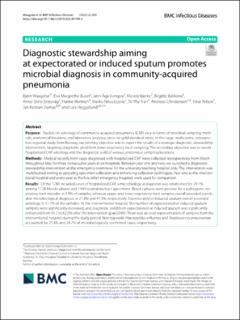| dc.description.abstract | Purpose: Studies on aetiology of community-acquired pneumonia (CAP) vary in terms of microbial sampling methods, anatomical locations, and laboratory analyses, since no gold standard exists. In this large, multicentre, retrospective, regional study from Norway, our primary objective was to report the results of a strategic diagnostic stewardship intervention, targeting diagnostic yield from lower respiratory tract sampling. The secondary objective was to report hospitalized CAP aetiology and the diagnostic yield of various anatomical sampling locations.
Methods: Medical records from cases diagnosed with hospitalized CAP were collected retrospectively from March throughout May for three consecutive years at six hospitals. Between year one and two, we launched a diagnostic stewardship intervention at the emergency room level for the university teaching hospital only. The intervention was multifaceted aiming at upscaling specimen collection and enhancing collection techniques. Year one at the interventional hospital and every year at the five other emergency hospitals were used for comparison.
Results: Of the 1280 included cases of hospitalized CAP, a microbiological diagnosis was established for 29.1% among 1128 blood cultures and 1444 respiratory tract specimens. Blood cultures were positive for a pathogenic respiratory tract microbe in 4.9% of samples, whereas upper and lower respiratory tract samples overall provided a probable microbiological diagnosis in 21.3% and 47.5%, respectively. Expectorated or induced sputum overall provided aetiology in 51.7% of the samples. At the interventional hospital, the number of expectorated or induced sputum samples were significantly increased, and diagnostic yield from expectorated or induced sputum was significantly enhanced from 41.2 to 62.0% after the intervention (p = 0.049). There was an over-representation of samples from the interventional hospital during the study period. Non-typeable Haemophilus influenza and Streptococcus pneumoniae accounted for 25.3% and 24.7% of microbiologically confirmed cases, respectively. Conclusion Expectorated or induced sputum outperformed other sampling methods in providing a reliable microbiological diagnosis for hospitalized CAP. A diagnostic stewardship intervention significantly improved diagnostic yield of lower respiratory tract sampling. | en_US |

